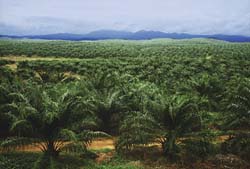 A picture of oil palm in Malaysia may seem a strange way to start notes on some CRC for Plant Biosecurity happenings but, read on.
A picture of oil palm in Malaysia may seem a strange way to start notes on some CRC for Plant Biosecurity happenings but, read on.

The project aims to determine the potential risks associated with climate change for key wheat pathogens; wheat using stripe rust, crown rot and Barley yellow dwarf virus and its aphid vector. The research approach is three-fold:
Climate change is clearly recognised as a major threat to agricultural systems. The expected increase in temperature, atmospheric CO2, heavy and unseasonal rains, increased humidity, drought and cyclones, are likely to affect crops, pests and diseases and host pathogen interactions. However, the extent to which climate change will affect emergency pests and pathogens and their hosts is not clearly understood. A review of the impacts of climate change on plant biosecurity (Aurambout et al. 2006) indicated a need to document pest and disease responses to climate change and incorporate them into our management and contingency planning. To respond to future climates, changes to industry practices and government policies may be required. This project will identify the potential risks associated with climate change and plant biosecurity. Adaptation plans will be developed around these risks to inform industry practice and policy.

This is a screenshot output from the Asian citrus psyllid - citrus growth model using the IPPC A1Fi climate change scenario with a Google Earth application. The ground overlay represents daily spatial variation in the population of adult psyllids displayed sequentially in an animation of 365 frames for the year 1990. The graphics depict temporal variations in the population of the Asian citrus psyllid and increasing temperature for the years 1990, 2030 and 2070 for a specific location. A total of 11,330 graphics can be accessed in the interface (one graph for each 50 km, two-grid cell on which the model was run) providing Australian coverage can be accessed in the interface (one graph for each 50km two-grid cell on which the model was run) providing Australian coverage.
The CRCNPB would like to thank Asia-Pacific Network for Global Change Research for their contribution to this project.

 A picture of oil palm in Malaysia may seem a strange way to start notes on some CRC for Plant Biosecurity happenings but, read on.
A picture of oil palm in Malaysia may seem a strange way to start notes on some CRC for Plant Biosecurity happenings but, read on.
This project developed an understanding of how biotic factors affect the dispersal of rain-splashed asexual spores (conidia) and wind-borne sexual spores (ascospores).
Once an exotic fungal pest has been introduced to a new area (such as via seed or soil) establishment and further spread are influenced largely by the spore dispersal pattern. Long-distance dispersal via wind-borne spores is a common feature of fungal pests, as is short-distance dispersal via rain-splash of spores. Studies that identify the link between environmental factors and spore dispersal can assist in assessing the potential disease risk for agrogeographical zones. Ascochyta species of pulse crops are already within Australia and have rain-splashed asexual spores (conidia) and wind-borne sexual spores (ascospores). These fungi provide an opportunity to study the relationship between the environment and spore dispersal, and to develop risk assessment strategies for exotic pests with similar spore dispersal patterns.
This project produced a new PhD graduate trained in Plant Pathology, with specific skills in plant disease epidemiology. The graduate was available for immediate employment within the Biosecurity industry, increasing Australia's capability to respond to disease outbreaks

Links:
[1] http://www.apn-gcr.org/
[2] mailto:Jo.Luck@dpi.vic.gov.au
[3] http://legacy.crcplantbiosecurity.com.au/content/luck
[4] http://legacy.crcplantbiosecurity.com.au/program/preparedness-and-prevention
[5] http://www.csiro.gov.au
[6] http://new.dpi.vic.gov.au/home
[7] http://www.planthealthaustralia.com.au/
[8] http://www.daff.gov.au/about/contactus/piaph/ocppo
[9] http://legacy.crcplantbiosecurity.com.au/chairreport1
[10] mailto:steven.coventry@adelaide.edu.au
[11] http://legacy.crcplantbiosecurity.com.au/content/coventry